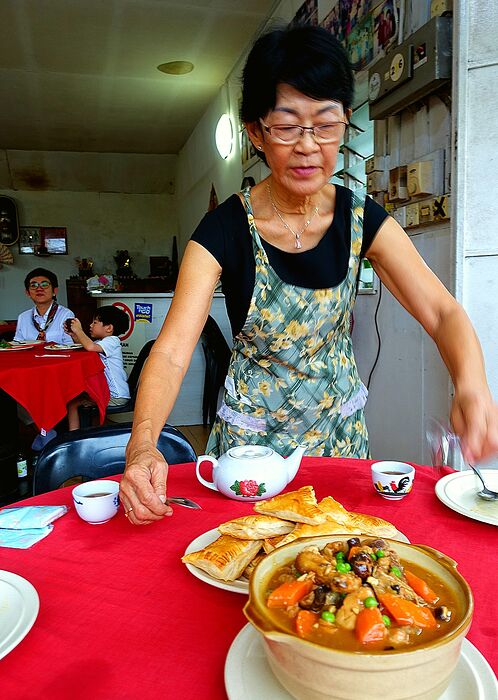We opted for a Hainanese dinner yesterday evening at Happy Garden in Penang’s Batu Ferringhi beach strip. Owner-chef, Tan Tee Yong, is one of the last of the dying breed of those traditionalist true-blue Hainanese chefs who’d dominated the culinary world of Singapore and Malaysia for more than a century. Back then, the Hainanese men would sally forth from their home island off the China coast to seek their fortunes in “Nanyang”, the “South Seas”, which was what the Chinese called South-east Asia in those days.
Known for their fortitude and dependability, the Hainanese in British Malaya carved out a niche for themselves as cooks and servers in households of the rich, the colonial officers, even the mess halls of the British army there. By the beginning of the 20th-century, no self-respecting British governor, or Malay sultan or king would be caught dead without a Hainanese chef in their kitchens. Every restaurant in the land, every cafe or coffeeshop, every bakery or even the tiny kitchens on-board the railway coaches or ships (cruise liner and naval warship alike) would have Hainanese chefs.
Historically, in British Malaya, the various Chinese ethnic groups came to dominate certain sectors of the economy: the Hokkiens were known for their merchants and traders, the Cantonese (and rival Hakkas) for their miners and coolies, the Teochews for street hawker food, the Hingwas in the transportation industry, and the Hainanese for being the preeminent dialect group dominating the hospitality and service industry, especially the kitchens in the top hotels and restaurants.
But times are a-changing: in the past 3 or 4 decades alone, young Hainanese no longer aspire to become chefs or own restaurants and bakeries like their forefathers. The lines have all but disappeared where ethnic-based work areas or economic sectors are concerned.
So it came to be that, in Singapore and Malaysia, people started looking back with dewy eyes at the hey-days of Hainanese restaurant food and cooking. “The food used to be so good back then. The restaurant had a real Hainanese chef” became a common catchphrase. People would flock to places where “one of the last Hainanese chefs” are still cooking. So, it it was for us when we heard that Happy Garden was owned and run by a Hainanese chef, and we simply lost no time getting here.
Happy Garden was, at first glance, like an elderly Chinese aunt’s home - a small, zinc-roofed Chinese village house, surrounded by abundant greenery and flowering shrubs that needed some trimming. The Tans bought this little house with its expansive grounds in 1985, and has been running their restaurant business here ever since.
Mr Tan had polished his cooking skills at Palm Beach, Penang’s oldest beach hotel, back in 1972. He’d then moved on to cook at another Hainanese-owned eatery, Jee Hooi, until 1978, before going to the United States for a few years to gain experience and earn enough to return to Penang and started Happy Garden 35 years ago.
Today, he still cooks the well-known classic dishes from the 1970s like choon phneah and roti babi, all served with delicious home-brewed Worcestershire sauce dip; Hainanese-style "Western dishes* like chicken chop and chicken pie; Nyonya staples like inche kabin; plus a variety of Hainanese noodle dishes. It’s strictly a mom-and-pop operation here - Mr Tan cooks and his wife, Sherine Lim, takes the orders, serves and clears the tables.
We started our dinner with:
- Choon Phneah - these are large deep-fried meat-and-vegetable-filled spring rolls. Besides the size, the traditional choon phneah is differentiated from the smaller popiah chee (deep-fried spring rolls) by the former’s mottled skin, as the choon phneah’s wrapper is made from flour, egg and water, whereas the smooth-skinned popiah chee* skin is eggless.
The choon phneah filling also has more meat filling, besides finely-julienned jicama, carrots, cabbage, onions, and sometimes crabmeat. Because of its size, each choon pheah is usually cut into 4 pieces before serving, whereas popiah chee are served whole. Choon phneah is usually served with a Worcestershire sauce dip, spiked with cut, red chilis.
- Roti Babi - this is a traditional street food dish, but served as an appetizer in some restaurants these days: basically a battered, deep-fried bread sandwich with minced pork and vegetable filling. The version here is pretty tasty - moist, flavorsome filling encased within a golden-fried bready crust. It’s also usually served with a Worcestershire sauce-red chili dip:
- Inche Kabin - this is a classic Nyonya dish of chicken pieces marinated in spices and coconut milk, usually overnight. The marinated chicken pieces are then dredged in flour and deep-fried till crisp on the outside and still moist inside, then served with prawn crackers. The version here has a slightly heavier-than-usual turmeric slant.
-
Hainanese Chicken Chop - a Hainanese coffeeshop mainstay: basically a flattened chicken cutlet which is batter-fried, then covered with a thick brown sauce consisting of onions, peas, tomato ketchup, soy sauce and other “secret” condiments. The version here was served on a bed of fresh lettuce leaves, and was pretty tasty.
-
Hainanese fried noodles - I’m not a fan of Hainanese-style noodles, which I always felt was a blander take on what the Cantonese serve up. But the version here was pretty good, actually, chockful of chicken-meat, shrimps and “choy sum” greens, covered with golden-fried shallots.
-
Hainanese fried bee hoon (rice vermicelli) - the thin rice vermicelli was cooked the same way as for the fried noodles, but presented a different texture. Also pretty tasty.
Located on the farthest reaches of Batu Ferringhi, Happy Garden is in a more “remote” part of Penang island, but certainly worth a drive out there for a taste of yesteryear’s cuisine.
Address
Happy Garden
206-B Batu Ferringhi, 11100 George Town, Penang, Malaysia
Tel: +6016 4903453
Opening hours: 6pm to 10.30pm daily


































